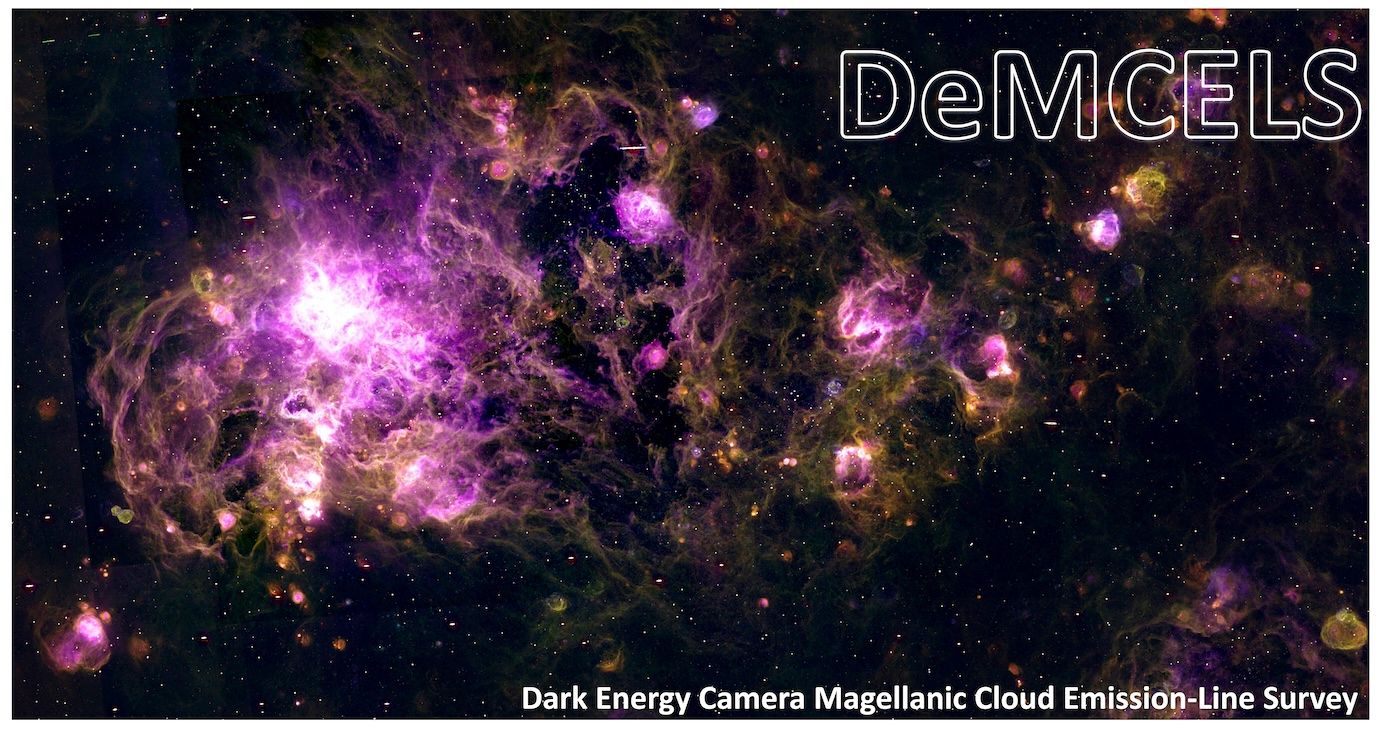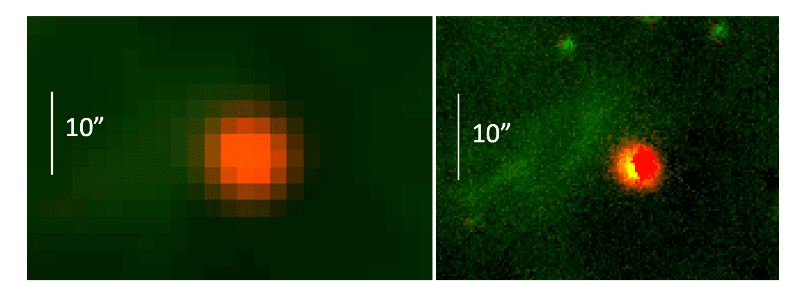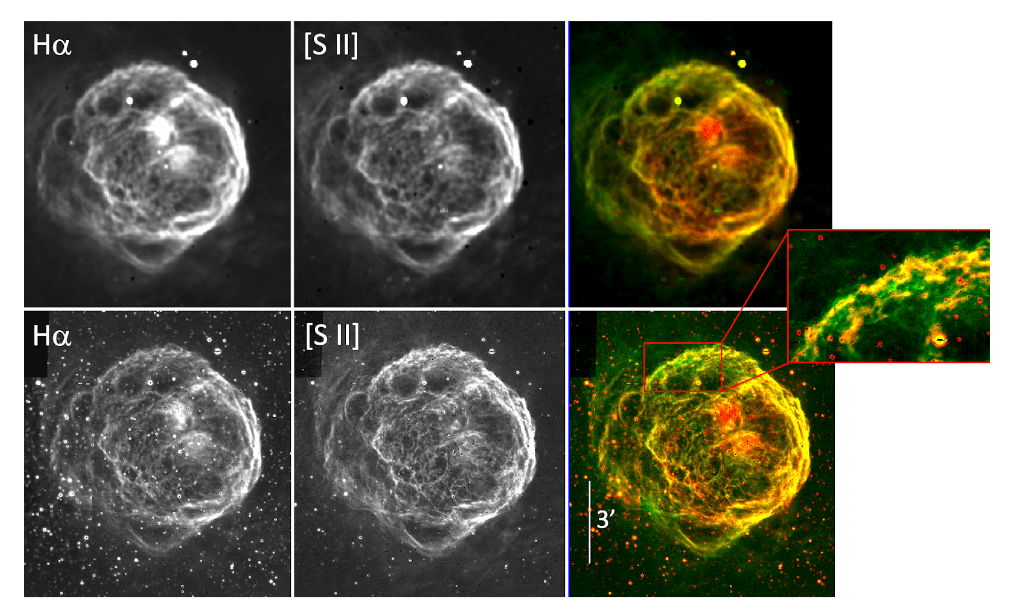DeMCELS (Dark Energy Camera Magellanic Clouds Emission Line Surveys)

Description
The Dark Energy Camera Magellanic Clouds Emission Line Surveys (DeMCELS) dataset is a compilation of multiple individual programs that used the Dark Energy Camera (DECam) and the narrow-band N662 and N673 filters to map the interstellar component of the Magellanic Clouds (MCs) to flux limits of a few x 10⁻¹⁸ erg s⁻¹ cm⁻² in the Hα and [SII] λλ6716,6731 emission-lines.
The Hα and [SII] data of the MCs presented here were not obtained at the same time. The Hα (N662) observations of the Large Magellanic Cloud (LMC) were taken as part of the "Chile-ChinA Reconnaissance of warM gas in Extragalactic NEarby REgions (CARMENERE)" survey led by Thomas Puzia and Eric Peng (PropID: 2018A-0909 and 2018B-0908). The [SII] observations of the LMC were taken as part of the "Deep [SII] Survey of the LMC with DECam" led by Sean Points (PropID: 2021B-0060). The Hα and [SII] observations of the Small Magellanic Cloud (SMC) were taken as part of the "Deep Hα and [SII] Survey of the SMC" led by Sean Points (PropID: 2022B-743998). More observations are planned for semester 2024B as part of the program "DECam Narrow Band Observations of the Magellanic Clouds" (PropID: 2024B-405106; PI: S. Points).
The DeMCELS data products presented here represent our effort to reduce these unique datasets as a whole and make them public to the wider astronomical community. Browse this page to learn more about DeMCELS and how to access the data. The DeMCELS overview paper of the LMC (Points et al. 2024) describes those surveys in detail. The data obtained toward the SMC will be described in a future data release.
| DeMCELS DR1 Summary | |
|---|---|
| LMC (long exposure time data) | |
| Area covered | 54 deg² |
| Bands | N662, N673, r |
| Flux limit (1DN) | 2.4x10⁻¹⁸ erg s⁻¹ cm⁻², 2.14x10⁻¹⁸ erg s⁻¹ cm⁻², 29.6 mag |
| Seeing (median) | 1.26, 1.11, 1.13 arcsec |
| Number of fields | 20 |
| Number of DECam exposures | 95, 243, 252 |
Scientific Goals
The DeMCELS data were obtained to investigate the warm (10⁴ K) ionized medium of the Magellanic Clouds. The main goals were to:
- Investigate recent star formation
- Explore the interaction between massive stars and the ambient interstellar medium
- Measure the [SII]/Hα ratios for a sample of known supernova remnants (SNRs) and SNR candidates
- Search for new SNRs based upon [SII]/Hα ratios
- Perform detailed multi-wavelength investigations of interstellar structures
- Enable many community-led science projects
Data Releases
DeMCELS DR1
The first data release only contains LMC data from the Puzia (2018A-0909 and 2018B-0908) and Points (2021B-0060) observations that cover the central 54 deg² region of the LMC optical disk.

Figure 1: The MCELS Hα mosaic of the LMC with 2 degree diameter circles representing the approximate DECam footprint overlaid for all narrow-band data of the LMC found in the NOIRLab Astro Data Archive.
Data Reduction and Calibration
The DeMCELS data reduction of the DECam data makes use of two separate software packages: (1) the Community Pipeline (CP) for instrument signature removal and (2) KRED, custom software written to process, mosaic, and calibrate the emission-line images in a uniform manner. The two packages are described below.
(1) Instrument Signature Removal: The NOIRLab DECam Community Pipeline (CP, Valdes et al. 2014) was jointly developed by the Dark Energy Survey Data Management (DESDM) team and NOIRLab to produce reduced and calibrated images for the community. The CP was used to perform the bias and crosstalk correction, linearity correction, flat field and illumination calibration, fringe pattern subtraction, astrometric and photometric calibration, and zeroth-order sky subtraction of the DeMCELS data.
(2) KRED: KRED is a set of python programs that use relatively common python modules, such as astropy, that run within an appropriate conda environment. KRED divides each DECam field into a 4x4 grid of separate "tiles". CP processed images are grouped by filter and exposure time for each tile. The KRED software finds a common background value for the detectors in each tile and performs the coaddition and reprojection of the detectors to produce stacked images. Stars in each tile are matched with objects from the Gaia DR3 catalog to provide the absolute flux-calibration.
Data Access
The DeMCELS images are available through the Data Lab Simple Image Access (SIA) service. See the How to use the Simple Image Access (SIA) service Jupyter notebook. For DeMCELS DR1, the SIA URL is:
https://datalab.noirlab.edu/sia/demcels_dr1
The images are also available through the Astro Data Archive, which provides multiple avenues towards accessing the data:
- https://astroarchive.noirlab.edu --> Web Search --> Search within Collections --> DeMCELS
- Direct link to #1: https://astroarchive.noirlab.edu/portal/results/collection/DeMCELS/
- Through any search that matches on metadata (RA/Dec, telescope, instrument, filter, etc)
- Access the entire file tree: https://astroarchive.noirlab.edu/hlsp/demcels/
Analysis
In order to analyze the DeMCELS data, individuals will need to find the fields and tiles that contain objects of interest. We provide this Jupyter notebook to facilitate the search based on our tile definitions.
Results
As discussed in Points et al. (2024) the DeMCELS data will enable investigations of the ISM of the Magellanic Clouds, including, but not limited to:
- HII regions
- Planetary nebulae (PNe)
- Stellar bubbles
- Supernova remnants (SNRs)
Some initial results from DeMCELS are shown below and compared to images obtained by the Magellanic Clouds Emission-Line Survey (Smith et al. 1999).

Figure 2: This image shows a comparison between MCELS and DeMCELS from a field that contains several small to very small star forming regions. The top row shows MCELS Hα and [SII] images in black and white, with a color combination at the right (red: Hα; green: [SII]). Yellow indicates that both ions are strong. The bottom row shows the same sequence, but for the DeMCELS data. The box at the right is 30". These smallest nebulae are unresolved by MCELS.

Figure 3: LMC planetary nebula SMP83. The MCELS data are shown at the left and DeMCELS at right, with Hα in red and [SII] in green.

Figure 4: A comparison of MCELS and DeMCELS data for N70, a superbubble ∼7.8' diameter, and located in an isolated region in the eastern LMC. Presentation is the same as Figure 2.

Figure 5: A comparison of MCELS and DeMCELS data for the SNR 0535-6918, aka the Honeycomb, within the outer regions of 30 Dor. The presentation is the same as Figure 2. The angular resolution of the DECam data is particularly effective in separating different kinds of emission in complex regions such as this one.
Additional Resources
Here we list prior investigations of the interstellar content of the Magellanic Clouds and object catalogs where available through the VizieR service at CDS, Strasbourg, France.
- Henize (1956): "Catalogues of Hα-Emission Stars and Nebulae in the Magellanic Clouds"
- Davies, Elliott, and Meaburn (1976): "The Nebular Complexes of the Large and Small Magellanic Clouds"
- Pellegrini et al. (2012): "The Optical Depth of HII Regions in the Magellanic Clouds"
Acknowledgments
All users are required to acknowledge the source of the data with an appropriate citation in their publications, using the following text:
"This research was enabled in part by data presented by Points et al. (2024) as part of DeMCELS based on observations at NSF Cerro Tololo Inter-American Observatory, NSF NOIRLab (NOIRLab Prop. ID 2018A-0909; PI: T. Puzia; NOIRLab Prop. ID 2018B-0908; PI: T. Puzia; and NOIRLab PropID 2021B-0060; PI: S. Points), which is managed by the Association of Universities for Research in Astronomy (AURA) under a cooperative agreement with the U.S. National Science Foundation.
This project used data obtained with the Dark Energy Camera (DECam), which was constructed by the Dark Energy Survey (DES) collaboration. Funding for the DES Projects has been provided by the U.S. Department of Energy, the U.S. National Science Foundation, the Ministry of Science and Education of Spain, the Science and Technology Facilities Council of the United Kingdom, the Higher Education Funding Council for England, the National Center for Supercomputing Applications at the University of Illinois at Urbana-Champaign, the Kavli Institute of Cosmological Physics at the University of Chicago, Center for Cosmology and Astro-Particle Physics at the Ohio State University, the Mitchell Institute for Fundamental Physics and Astronomy at Texas A&M University, Financiadora de Estudos e Projetos, Fundação Carlos Chagas Filho de Amparo, Financiadora de Estudos e Projetos, Fundação Carlos Chagas Filho de Amparo à Pesquisa do Estado do Rio de Janeiro, Conselho Nacional de Desenvolvimento Científico e Tecnológico and the Ministério da Ciência, Tecnologia e Inovação, the Deutsche Forschungsgemeinschaft and the Collaborating Institutions in the Dark Energy Survey. The Collaborating Institutions are Argonne National Laboratory, the University of California at Santa Cruz, the University of Cambridge, Centro de Investigaciones Enérgeticas, Medioambientales y Tecnológicas–Madrid, the University of Chicago, University College London, the DES-Brazil Consortium, the University of Edinburgh, the Eidgenössische Technische Hochschule (ETH) Zürich, Fermi National Accelerator Laboratory, the University of Illinois at Urbana-Champaign, the Institut de Ciències de l'Espai (IEEC/CSIC), the Institut de Física d'Altes Energies, Lawrence Berkeley National Laboratory, the Ludwig-Maximilians Universität München and the associated Excellence Cluster Universe, the University of Michigan, the National Optical Astronomy Observatory, the University of Nottingham, the Ohio State University, the University of Pennsylvania, the University of Portsmouth, SLAC National Accelerator Laboratory, Stanford University, the University of Sussex, and Texas A&M University.
The NSF NOIRLab is operated by the Association of Universities for Research in Astronomy (AURA) under a cooperative agreement with the National Science Foundation. Database access and other data services are provided by the Astro Data Lab, which is part of the Community Science and Data Center (CSDC) Program of NSF NOIRLab."
